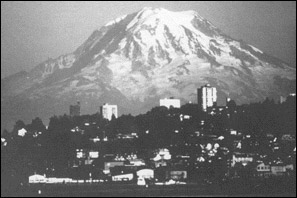
CONCLUSIONS
Since 1977, significant advances have been made in the measurement of gas emissions
to monitor active volcanoes. The underlying principle in gas monitoring is that
changes in the composition of the emissions are related to major subsurface movement
of magma. In general, as the magma rises closer to the surface, the magmatic
component of the gas mixture, collected and analyzed at the surface, increases at the
expense of nonmagmatic gases derived mainly from the atmosphere and meteoric waters.
Currently at Kilauea more than 10 different species of gas are monitored at 25 sites,
sampled at least twice a week, to try to detect departures from "normal" or
background amounts. The data from this systematic gas monitoring show that the
changes in composition of the emissions can be related to the inflation (swelling)
and deflation (shrinking) of the magma reservoir.

|
|
Snow-covered Mount Rainier, rising behind Tacoma,
Washington. Because of its historic activity and proximity to
major population centers, Mount Rainier is targeted for intensified
study during the coming decade.
|
Measurements of sulfur dioxide gas have proved useful at Mount St. Helens, Kilauea,
and other volcanoes. The continuous monitoring of hydrogen emissions at Mount St.
Helens, Kilauea, Mauna Loa, and Mammoth Lakes is currently being done remotely by
using sophisticated electrochemical sensors and satellite transmission of collected
data. Data obtained to date suggest that the monitoring of hydrogen emissions
promises to be an effective technique, especially at places too inaccessible and/or
dangerous for frequent direct gas sampling by conventional means.
Tremendous strides have been made in recent years in intensifying the monitoring of
Mauna Loa and Kilauea as part of the Volcano Hazards Program, and understanding of
the typically nonexplosive, Hawaiian-type of volcanism has increased markedly. But
reliable and specific prediction capability for eruptions in Hawaii still eludes the
scientists. The predictive capability is much poorer for explosive volcanoes, such as
those in the Cascade Range of the northwestern United States (Mount Rainier, Mount
Hood, Mount Lassen), Alaska, and elsewhere around the Circum-Pacific "Ring of Fire."
The explosive Cascade volcanoes (for example, Mount St. Helens), which have erupted
only rarely within recorded historic times, are potentially much more destructive and
deadly than Hawaiian volcanoes. Should they erupt violently, large population centers
in the northwest, such as Seattle and Portland, could be threatened by mudflows and
ashfalls if wind directions are unfavorable. Clearly, present intensive monitoring of
Hawaiian volcanoes should be maintained, and fundamental studies and systematic
monitoring of the Cascade and Alaskan volcanoes should be expanded and accelerated.
[ Previous |
Table of Contents |
USGS Geologic
Information - General Interest Publications ]
This page is URL: https://pubs.usgs.gov/gip/monitor/conclusions.html
Maintained by John Watson
Last updated 4.30.99


